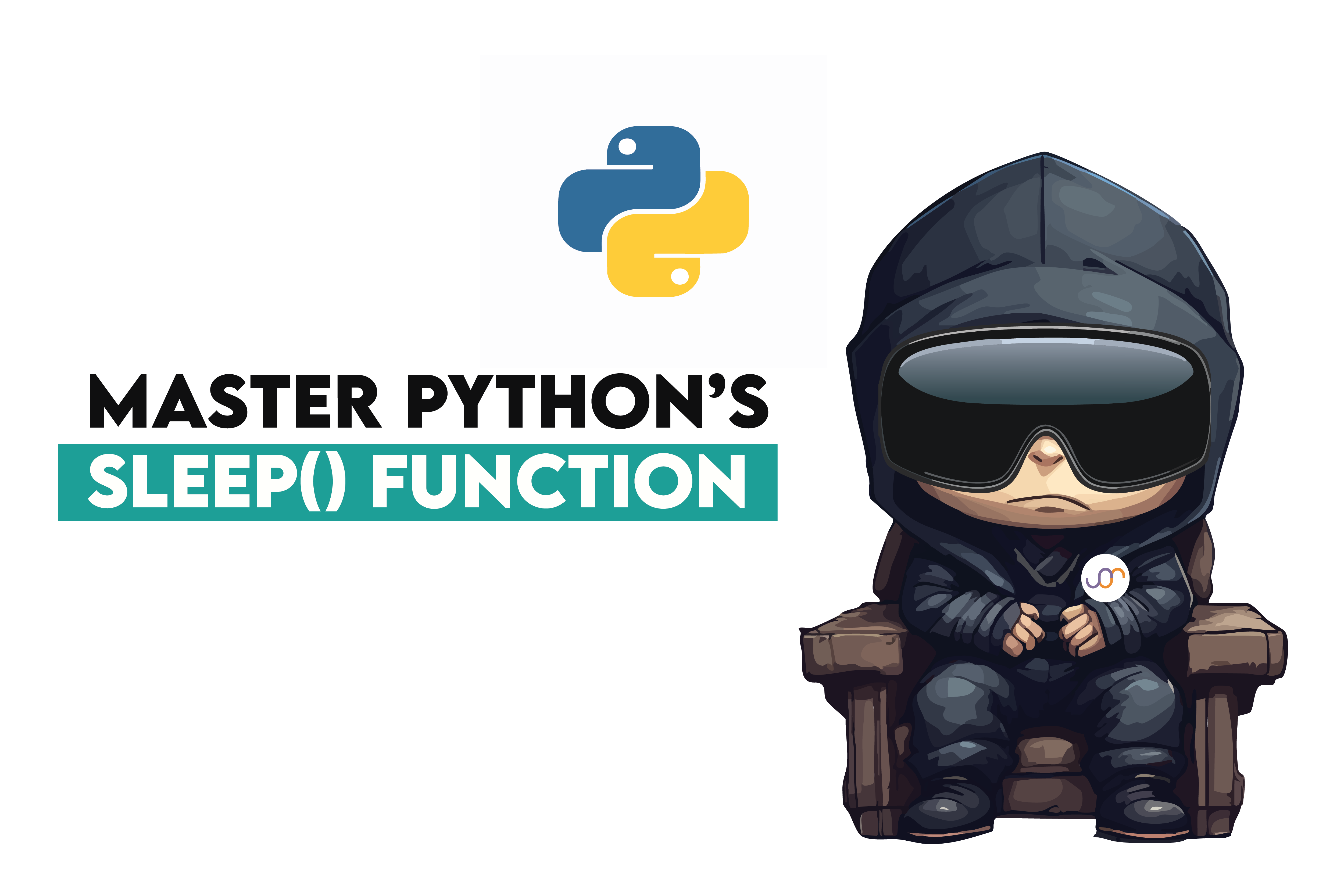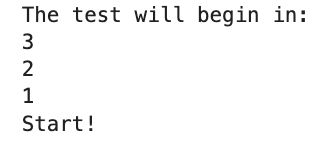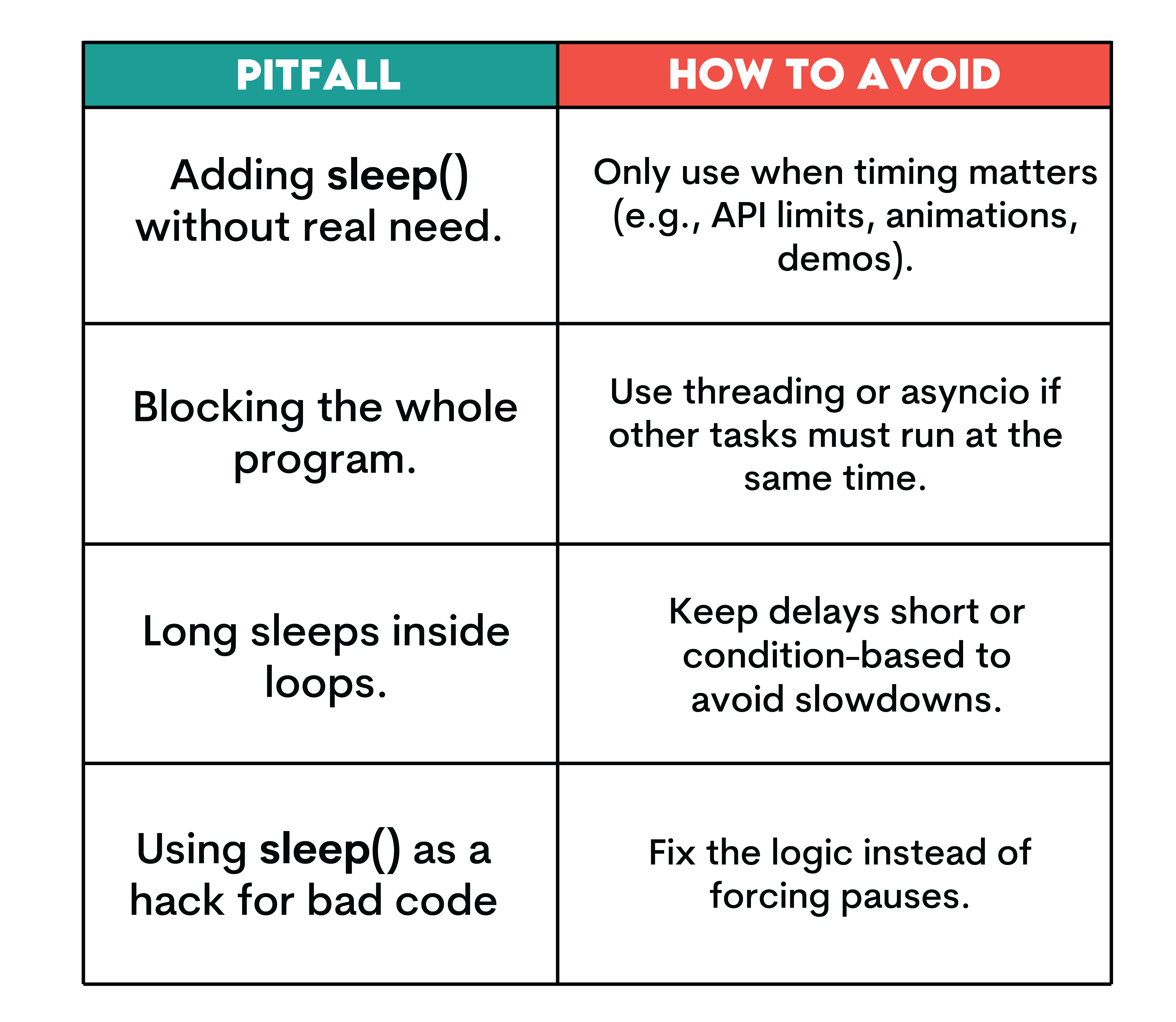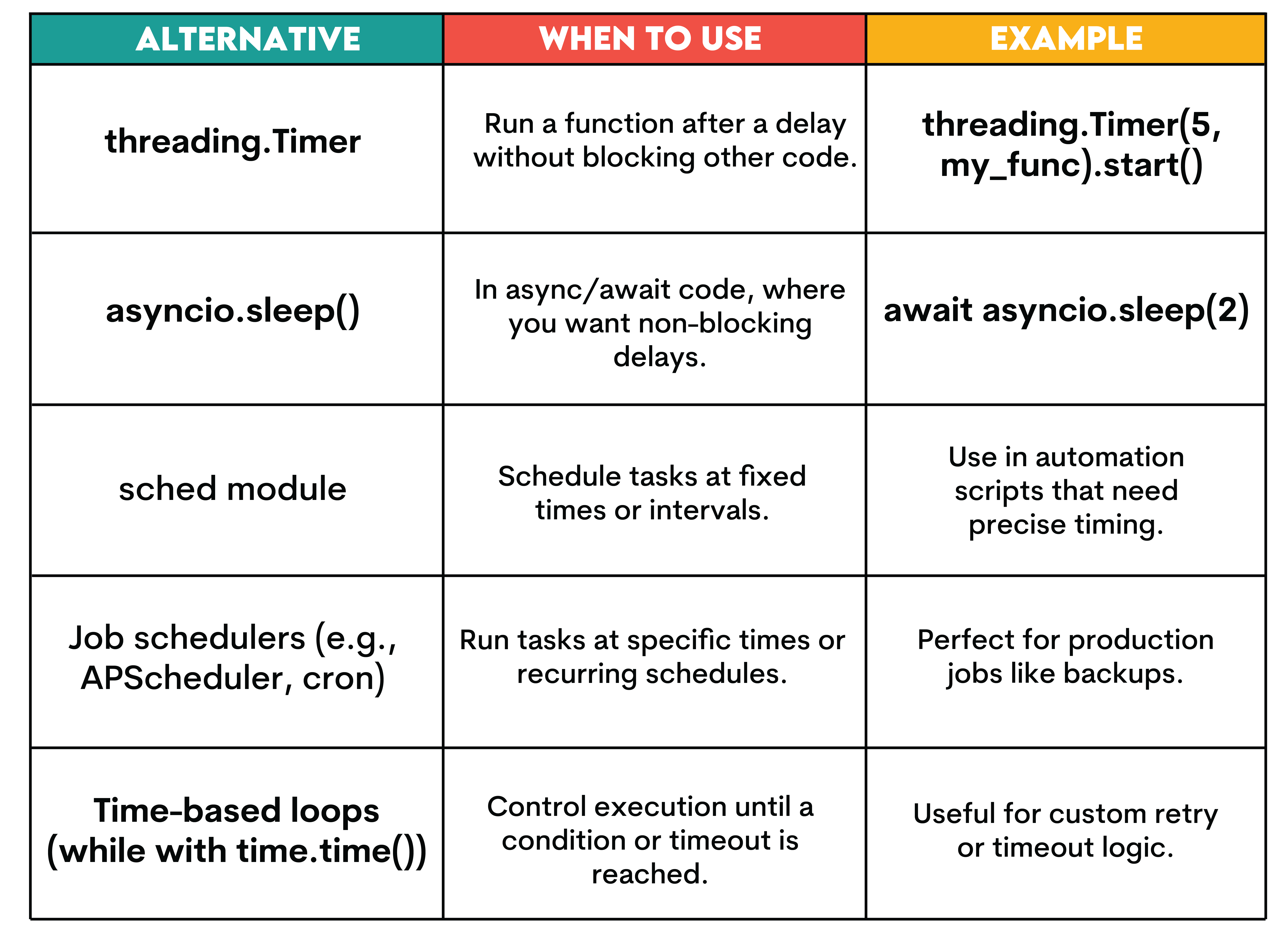How to Use Python’s Sleep Function

Categories:
 Written by:
Written by:Nathan Rosidi
Learning how the Python sleep function works and how to apply it for timing control, automation, and data processing tasks
One of the easiest ways to control timing in Python is to use the sleep() function. It takes seconds as an argument and can be used for API rate limiting, simulating delays, and improving user experience.
In this guide, I’ll show you how it works, when to use it, and what to watch out for.
What is sleep() in Python?
Python sleep() is a built-in function from the Python’s time module. That means you don't have to install anything to use it, just import it, like this:
from time import sleepWhat it does is stop your program from running for a certain amount of time. You could think of it as a short-term "wait" order. The program does nothing else while it sleeps; it just stays still.
If you’d like to explore more advanced techniques for introducing execution delays, check out the Python WAIT Function, a powerful alternative for handling timed pauses and synchronization in Python scripts.
Example Dataset: The db_employee Table
In this article, we’ll use the db_employee dataset. Here is the link to the question that has this dataset. Below are its columns, along with their descriptions:
This dataset was used in one of the Python interview questions asked by LinkedIn and Dropbox. In this question, we are asked to calculate the difference between the highest salaries in the marketing and engineering departments.
Last Updated: November 2020
Calculates the difference between the highest salaries in the marketing and engineering departments. Output just the absolute difference in salaries.
DataFrames
Expected Output Type
pandas.DataFrame
We will not solve this question, but we’ll use the db_employee dataset. To solve this question, here is the hint:
Solve this question by joining employee and department data, filtering by department, finding the maximum salary in engineering and marketing, and then calculating the absolute salary difference between the two.
How to Use Python Sleep Function: Syntax and Parameters
You call Python sleep() by giving it a number. That number sets how many seconds the program will pause. sleep() accepts both integers and floats. This gives you flexibility for short or long delays.
Before using sleep(), let’s import it from the time module:
from time import sleep
Let’s write code to use both integer and float seconds.
from time import sleep
print("Step 1")
sleep(2)
print("Step 2")
sleep(2.5)
print("Step 3")
Here is the output.

The code writes "Step 1" first and then waits for two seconds. It pauses for 2.5 seconds after writing "Step 2" before proceeding.
This shows that sleep() works effectively with both types of numbers.
Using Python sleep() in Real-World Scenarios
In real-world data projects, you often run long or multi-step operations. Using Python sleep() between steps can help simulate progress and improve the user experience.
Let’s say you're analyzing employee salary data from the db_employee dataset. You want to show each processing stage with a small pause to make things more readable:
from time import sleep
import pandas as pd
df = pd.read_csv("db_employee.csv")
print("Step 1: Data loaded.")
sleep(1.5)
print("Step 2: Filtering department_id = 3...")
sleep(1.5)
df_filtered = df[df['department_id'] == 3]
print("Step 3: Calculating average salary...")
sleep(1.5)
avg_salary = df_filtered['salary'].mean()
print(f"Average salary in department 3: ${avg_salary:,.2f}")
Here is the output.

Every sleep() adds a little extra time, so the steps don't feel rushed. This makes it easy to see how things work, especially in live demos, educational notebooks, or command-line scripts.
Common Use Cases for Python’s time.sleep()
Now let’s discover four common use cases of the sleep function.
1. Preventing API Rate Limit Errors
Some APIs don't let you send too many requests in a short time. To avoid getting blocked or throttled, you can pause between calls:
from time import sleep
for i in range(3):
print(f"Sending API request {i + 1}")
sleep(1) # pause 1 second between each
Here is the immediate output.

After 3 seconds, the output is as follows.

It’s essential when working with APIs that limit the frequency of connections.
2. Countdown Before an Action
Sometimes you want to give users time before something starts. Useful in CLI quizzes, tests, games, or screen recordings:
from time import sleep
print("The test will begin in:")
for i in range(3, 0, -1):
print(i)
sleep(1)
print("Start!")
Once you run this code, here is the immediate answer:

And here is the entire output after 3 seconds.

It makes transitions feel smoother and more interactive.
3. Simulating Delayed Output
People could miss important messages if your script prints too quickly. With this trick, each message looks like it was sent on purpose, like a real machine at work:
from time import sleep
print("Connecting to database...")
sleep(1.5)
print("Connection established.")
Here is the immediate output:

Here is the entire output.

Slowing things down makes the flow easier to follow.
4. Delaying Messages in a Chatbot
Let’s say you’re building a chatbot or automated assistant. Instead of dumping all messages at once, you can add pauses between replies:
from time import sleep
print("Bot: Hi there!")
sleep(1.2)
print("Bot: How can I help you today?")
sleep(1.2)
print("Bot: You can ask me about your balance, recent transactions, or support.")
Here is the output after one second.

Next, it outputs the question.

Here is the entire output.

This makes the interaction feel more natural and human-like.
Advanced Usage of Python Sleep Function
In real projects, you often deal with large amounts of data and slow operations. The Python sleep function helps simulate realistic timing and control flow across complex scripts. Let’s use the db_employee.csv dataset to demonstrate.
Retry Mechanism in Heavy Computations
When working with large datasets or cloud-based pipelines, data might not be ready instantly.
Retry logic gives the system multiple chances to succeed before failing.
Here, we try to find employees earning over $100,000. If not found, we retry five times with a delay.
from time import sleep
import pandas as pd
df = pd.read_csv("db_employee.csv")
attempt = 0
max_attempts = 5
while attempt < max_attempts:
high_salary = df[df['salary'] > 100000]
if not high_salary.empty:
print("✅ Found high salary employees.")
break
else:
attempt += 1
print(f"Attempt {attempt}: No high salaries found. Retrying in 1.5s...")
sleep(1.5)
else:
print("❌ Max attempts reached. No data found.")
Here is the output.

This is useful when:
- Data arrives late from another system
- You need to handle delays without crashing the script
- Computational power is costly, so you don't retry continuously
Timeout Simulation for Long-Running Jobs
Let’s say you're running a data quality check across employee records. If the operation exceeds a set time limit (e.g., 3 seconds), it stops and warns the user. This prevents endless loops or stuck processes.
from time import sleep
import pandas as pd
import time
df = pd.read_csv("db_employee.csv")
start = time.time()
timeout = 3 # seconds
for _, row in df.iterrows():
print(f"Processing {row['first_name']} {row['last_name']}")
sleep(1)
if time.time() - start > timeout:
print("⏳ Timeout reached. Stopping process.")
break
Use this when:
- You want to abort long-running loops
- A job hangs on slow data
- You need to protect system resources
Threaded Output With Controlled Speed
Suppose you’re printing employee names and salaries at the same time. One function prints names, the other prints salaries. Without control, outputs can get mixed and unreadable. With sleep() and threading in Python, we can slow things down and coordinate the flow.
from time import sleep
import pandas as pd
import threading
df = pd.read_csv("db_employee.csv").head(5) # only show top 5 rows
def print_names():
for _, row in df.iterrows():
print(f"Name: {row['first_name']} {row['last_name']}")
sleep(0.7)
def print_salaries():
for _, row in df.iterrows():
print(f"Salary: {row['salary']}")
sleep(1)
t1 = threading.Thread(target=print_names)
t2 = threading.Thread(target=print_salaries)
t1.start()
t2.start()
t1.join()
t2.join()
Here is the output.

This is useful when:
- You’re building real-time logs or dashboards
- You want multiple outputs to run in parallel
- You simulate asynchronous workflows
Pitfalls and Best Practices for Using Python Sleep

Alternatives to Python’s time.sleep()

Conclusion
Python sleep() is one of the simplest tools in your toolkit. It helps add pauses for API limits, user interaction, and step-by-step demos.
But keep in mind: it blocks the program while waiting. That makes it dangerous for critical or long-running tasks. Use sleep() when you need quick timing fixes or controlled delays. Switch to asyncio, threading, or schedulers for advanced workflows.
Share


